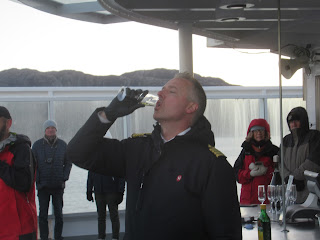Bergtatt, Marvellous Marble Mine
A chandelier in the marble mine that we would be visiting.
The bridge across the entrance to Kristiansund.
A view of the harbour at Kridtiansund, and just a little further on is the Klippfisk Lady, a statue of a lady holding a klipfisk for which the town is famous. The city's wealth was created by selling salted cod known locally as klipfisk whereas stock fish is air dried cod......and the stone built church on the far side of the harbour...
...the town's waterfall...
...the Atlantic tunnel 5.7 kilometres long and up to 250 metres below sea level. Newly built tunnel and bridges have a toll to repay the cost of construction but once the costs are recovered, passage is free.
The stone circle where king Harald Fairhair swore to unite Norway, which at the time was a divided area with chieftains and minor kings governing just their own area. He was in love with a beautiful women, the daughter of a rich family but her response to his proposal of marriage was that she would only marry the king of Norway,
Harald Fairhair swore an oath in that stone circle tat he would not shave his beard or cut his hair until he had united Norway. He set about his task and by 885AD he had united the country and married his love.
It was a long drive through forest and countryside. There are a lot of deer in the forests but only a few moose as they don't like each other. Where there is a lot of one, there are few of the other. The bears were hunted and were either killed or moved away. The top predators here today are wolverine and the elusive lynx, although we saw no big animals.The shore line is littered with small islands and sherries sticking out of the water making navigation difficult in these shallow waters.
We were driving along the Atlantic Road.
The Atlantic Road is only eight kilometres long but it has eight bridges connecting a series of small islands.
The sunset.
There was an entrance to another chamber called the Grand Hall. There were facilities in one corner...
...and marble chandeliers hanging from the ceiling.
A detail of one of the chandeliers, weighing 300 kilos...
...another chandelier weighing 700 kilos...
We put on helmets and life jackets and boarded some boats to take us through some of the flooded former mine workings. An electric light but made to look like a shimmering paraffin lamp.
Some chandeliers with the lights reflected off the surface of the water.
The Mountain Goddess.
An underground reception area. The desk is made from marble with ordinary lights behind it and shining through the marble.
A detail of the chandelier.
The water is full of minerals with a ph of 8.4 so it is alleged to be very beneficial and we had a tasting. Then it was time to show some tricks, such as shining a torch through a polished slab of marble. The white is pure marble, the black is host rock and the red and oranges are where minerals have leached into the marble to give it colour.
A piece of pure marble sitting on top of a torch and the light is defused in all directions by the marble.
Leaving the reception area with underwater lights illuminating the crystal clear waters which in places is up to 12 metres deep. We navigated through several more flooded tunnels on silent electric boats back to the concert hall.
One of the wall lights in the concert hall.
The stage and the tables set in front of it. We were treated to some beef soup and bread as we watched a pop concert that had been recorded in the underground concert hall.
Off to one side was a large collection of miners' lamps dating as far back as 1850s although this mine had only started in 1930s.






































































